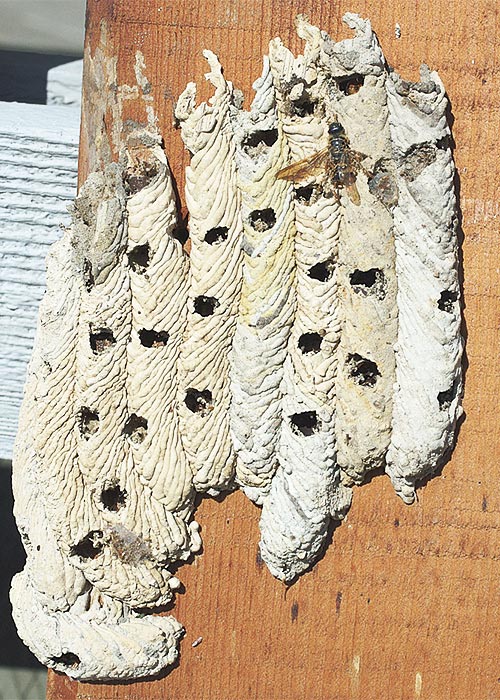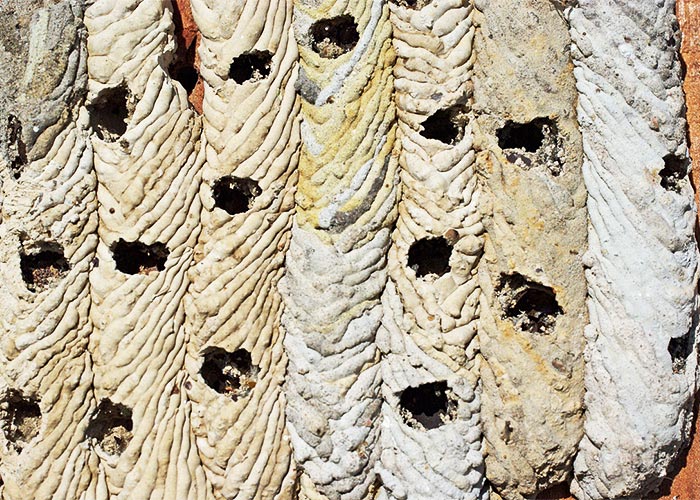Howdy, BugFans,
Organ Pipe/Pipe Organ Mud Dauber
The BugLady had fun photographing the deconstruction of an old farmhouse recently (in a deconstruction, everything useable gets recycled, not land-filled). On the outside walls, under the cedar shake siding, were long, skinny tubes and fist-shaped globs made by generations of mud wasps. The mud tubes that look like part of a pipe organ were made by a wasp called, logically, the Organ Pipe/Pipe Organ Mud Dauber (Trypoxylon politum). There are about 30 species in the genus across North America (more elsewhere), but the OPMD is found mostly in the eastern U.S. At about an inch in length, the OPMD is the largest member of its genus, which is in the family Crabronidae.
These smallish wasps are patent-leather black, with purplish wings and white “ankles” on their back legs. They are not aggressive—males have no stingers, and you really have to man-handle a female to get her to sting.
Other species of the genus use existing structures and natural cavities, but Ms. OPMD creates her own. She picks a sheltered nest site near a supply of mud and then she plows into the damp ground, picks up mud with her mandibles, forms it into a ball, and grasps the ball with her front legs. When she has all she can carry, she flies back to her nest, mixes the mud with her saliva, and uses her forehead to smear the mud balls out into long strips, first on one side, and then on the other. A typical “pipe” is about six-inches long, made up of no more than six sections or cells, and there might be five to seven pipes in a cluster. One source said that a pipe might be constructed in a day.
She is a noisy worker and her buzzing is amplified by the tube she is working on, as though she were playing bagpipes. Although solitary, she tolerates her sister mud daubers nearby, and aggregations of “organ pipes” can be impressive. When she has finished the first cell in the pipe, she hunts.
Solitary wasps capture a variety of prey for their soon-to-be infants. OPMDs specialize in orb-weaving spiders, and a cell does not pass muster until it holds between five and twenty of them. When it meets her specifications, she mates at the nest, lays an egg on the larder, caps the cell with mud, and begins building the next chamber. Alternatively, she may evict another female from a nest, she may cooperate with another female in building and provisioning a nest, or she might remove another female’s eggs from a provisioned cell and insert her own.
Male OPMDs play an important role in the project (besides contributing genetic material). A female who is off collecting mud or spiders is, by definition, not at the nest, and leaving a nest unguarded is perilous. At the very least, the hard-won spiders might be snitched by other wasps, but kleptoparasites and parasites may lay their eggs in the cell—the young of the first group will hatch in the cell and eat the larval wasp’s provisions; the young of the second group will eat the OPMD larva itself. Male OPMDs guard the nest from predators, parasites, and from other males aggressively and vocally, night and day (she is no homebody and only visits to deliver mud or spiders). In some species of Trypoxylon, he not only guards the cells, he cleans them out, stashes the food that she brings, and helps spread mud. Wasps that collaborate like this are called Patriarchate wasps. The pair bond of the OPMD lasts only through the construction of a single pipe.
Behind closed doors, an egg hatches, and the OPMD larva chows down on its cache of paralyzed spiders. It takes about a week to finish them (except the legs), then the OPMD larva spins an outer silk cocoon and makes an inner pupal case where it spends the winter as a prepupa. Being encased in mud is not as secure as one might think, and various parasites/parasitoids take a toll on young larvae. The OPMD emerges as an adult in early summer, first exiting the pupal case and then chewing out through the mud.
A few interesting tidbits about OPMDs, gleaned from the scientific literature:
- OPMDs reputedly have few avian predators, but a researcher in Atlanta observed a Tufted Titmouse preying on OPMD larvae one snowy morning. The holes that the titmouse made to extract the larvae from their mud chambers looked so similar to the holes adult OPMDs make when exiting naturally that the researcher wonders how much bird predation is overlooked.
- The eggs that she lays in the mud cells will produce both male and female wasps; fertilized eggs become females, and males develop from unfertilized eggs (this is typical in the Hymenoptera—the ants, bees and wasps). Researchers observed that the female stashes more spiders in cells that are destined to house fertilized eggs. A better-nourished larva is a larger larva, and a larger larva morphs into a larger adult. Female insects need to be bigger than males because it takes extra energy to produce young.
- In the confusing world of kairimones (chemicals an organism produces that seem to work against it), OPMD larvae produce, during their active larval stage, protective kairimones that discourage the tiny ectoparasitic wasp Melittobia digitata from exploiting the OPMD larvae (ectoparasites feed on the outside of their host). The OPMD larva stops producing these chemicals as it enters its prepupal stage, and the Melittobia zooms in to lay her fast-maturing eggs. Melittobia digitata is a pretty interesting gal herself—males are blind and flightless, feisty and passionate. A female lays a few unfertilized eggs to produce some males, mates with one of her sons (be quiet, Sigmund), and then lays fertile (female) eggs on host insects.
- The folks in Radiation Ecology back at the Oak Ridge National Laboratory have analyzed mud nests made by the OPMD and by the Black and Yellow Mud Dauber, of previous BOTW fame. They wanted to find the source(s) of the mud that the two species use to build their nests, side by side, on the Atomic Energy Reservation at Oak Ridge. The BYMD will readily use radioactive mud from the site’s waste disposal pits, (maybe there’s another reason the BYMD is black and yellow) but the OPMD seldom does.
There are, of course, exterminator sites that offer to extinguish these wasps for us, but why? OPMDs don’t sting, bite, chew or excavate; they just hunt spiders and pollinate flowers in the process. And their architecture is grand!
Check out this excellent article about OPMDs, with great pictures on the Hilton Pond Center for Piedmont Natural History website.
The BugLady

